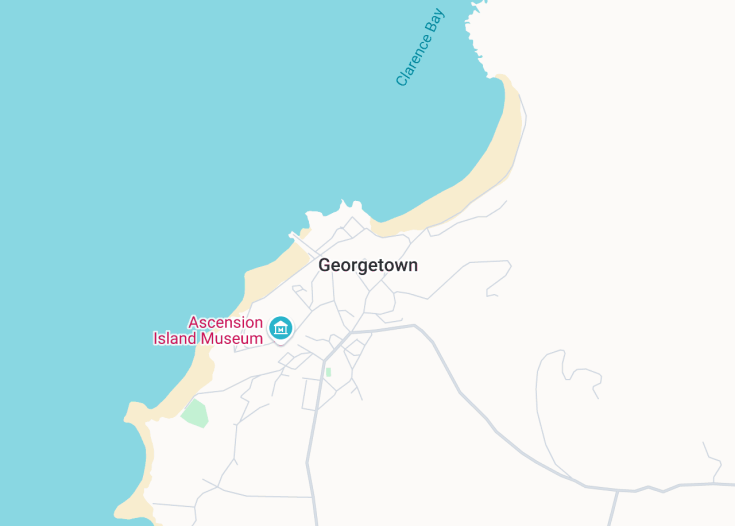Nestled on the rugged, volcanic shores of Saint Helena, Georgetown serves as the administrative heart of Ascension Island. This serene and tiny capital charms with its blend of rich history and natural beauty. Visitors can explore historic forts, pristine beaches, and unique biodiversity, making it a perfect getaway for those interested in the tranquility and exploration of remote islands. Georgetown offers a distinctive blend of cultural heritage and environmental preservation, providing a quiet but profound insight into island life.
Consider visiting during the cooler months from June to September for a more comfortable exploration of Georgetown’s outdoor attractions.
Don’t miss the Georgetown pier for a picturesque sunset view. It’s an ideal spot for photographers and nature lovers alike.
Top things to do & see in Georgetown
Select the following sights and activities to discover best tickets and tours available in Georgetown.
Georgetown: A Glimpse into Britain’s Remote Outpost
| Country | Saint Helena (United Kingdom) |
| Time in Georgetown | GMT-0 |
| Language spoken | English |
| Population | 1,406 (2023 estimate) |
| Currency | Saint Helena Pound (£, SHP) |
| Airports |
|
Georgetown, situated in Saint Helena, a territory of the United Kingdom, serves as a fascinating study in isolation and the resilience of community. Nestled in the South Atlantic Ocean, this quaint town not only boasts rich historical artifacts but stands as a living museum of colonial architecture intertwined with modern-day advancements. Once a vital port during the era of British maritime dominance, Georgetown today reflects a blend of cultures shaped over centuries of migration and trade.
Where is Georgetown?
Positioned on the northeastern coast of Saint Helena, Georgetown offers a unique landscape shaped by volcanic origins.
Distances:
| Route | Distance by car | Time by car |
|---|---|---|
| Jamestown to Georgetown | 14 miles (22.5 km) | 20 mins |
| Longwood to Georgetown | 10 miles (16 km) | 15 mins |
| Half Tree Hollow to Georgetown | 11 miles (18 km) | 17 mins |
What is Georgetown famous for?
Georgetown is renowned for its historical significance and well-preserved colonial buildings. It’s a key location for learning about Saint Helena’s past and its strategic importance to British naval history.
History
1502-1815: Early Exploration to British Colonization
Georgetown’s story begins with its discovery by the Portuguese in 1502, named after Portugal’s Saint Helena. By the mid-17th century, the British took control, realizing the island’s strategic importance for ships navigating to Asia and South Africa. The British East India Company established Georgetown in 1815, fortifying it to protect their route to India and using it as a resupply point for ships.
1815-1834: Napoleonic Exile and Development
Significantly, Georgetown gained international prominence when Napoleon Bonaparte was exiled to Saint Helena in 1815. He was hosted in Longwood House, close to Georgetown, until his death in 1821. His presence brought many visitors to the island, which enhanced the town’s development as infrastructure improvements were made to accommodate distinguished visitors and British troops.
1834-Present: Evolution and Modernization
Post-Napoleon, Georgetown continued to serve as a vital naval and communications outpost. Its role evolved with the development of telecommunication cables and wireless stations in the 19th and 20th centuries, connecting Africa and Europe. Today, Georgetown maintains its heritage while adapting to modern needs, focusing on tourism and fishing as primary economic drivers. The preservation of its historical sites and the enhancement of local infrastructure mark its journey into the 21st century.
Visit Georgetown
What to see and do in Georgetown, Saint Helena (United Kingdom).
Exploring Georgetown offers a unique blend of natural beauty and historic sites. Key attractions include:
- The Jacob’s Ladder: A challenging ascent offering panoramic views of the town and harbor.
- Longwood House: Napoleon’s residence during his exile, now a museum.
- The Museum of Saint Helena: Showcasing local history and cultural exhibits.
- St. James’ Church: The oldest Anglican church in the southern hemisphere.
- Plantation House: The official residence of the Governor, surrounded by lush gardens and the home of Jonathan, the famous tortoise.
Additionally, diving and fishing are popular activities, taking advantage of the island’s rich marine life.
Annual Events in Georgetown
Georgetown hosts several cultural and historical events throughout the year. Notable among them are:
- The Napoleon Festival in May, celebrating the island’s ties to Napoleon Bonaparte with reenactments and lectures.
- The St. Helena Day on May 21, featuring parades, sports, and community festivities commemorating the island’s discovery.
- The Festival of Running in November, inviting athletes for marathons and fun runs across the challenging terrain.
These events draw both locals and tourists, enriching the town’s social life and offering visitors a deeper connection with its history and people.
Best time to visit Georgetown
The ideal time to visit Georgetown is between April and June, when the weather is most favorable. This period avoids the rainy season, providing clear skies and cooler temperatures, making it perfect for exploring the outdoor attractions and participating in local events.
Is Georgetown worth visiting?
Georgetown offers a distinct blend of historical intrigue and natural beauty, making it a noteworthy destination. The rich history linked to Napoleon, alongside well-preserved colonial architecture and breathtaking landscapes, offers much for the curious traveler. However, its remote location requires significant travel commitment, which might not appeal to everyone. The limited accessibility might pose a challenge, but for those intrigued by history and natural beauty, Georgetown remains a captivating destination that is definitely worth the visit.










